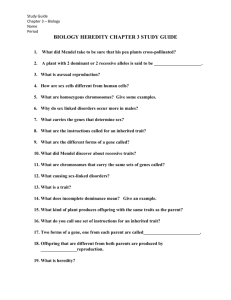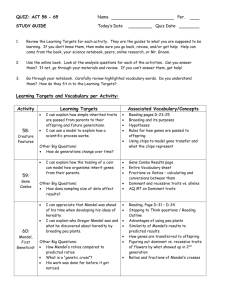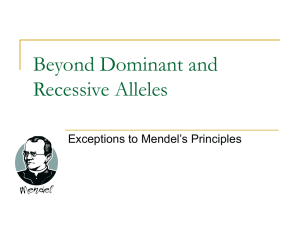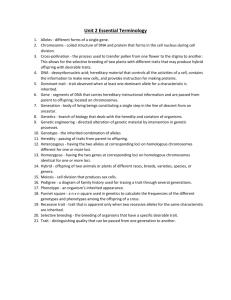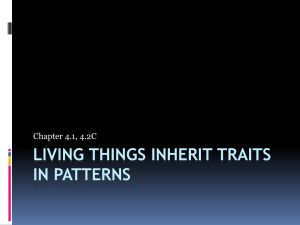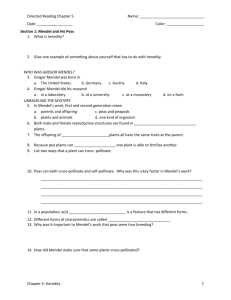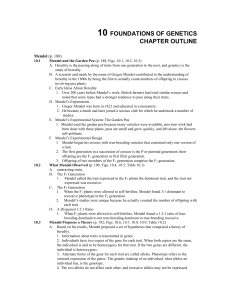Heredity: Mendel's Peas & Genetics Study Guide
advertisement
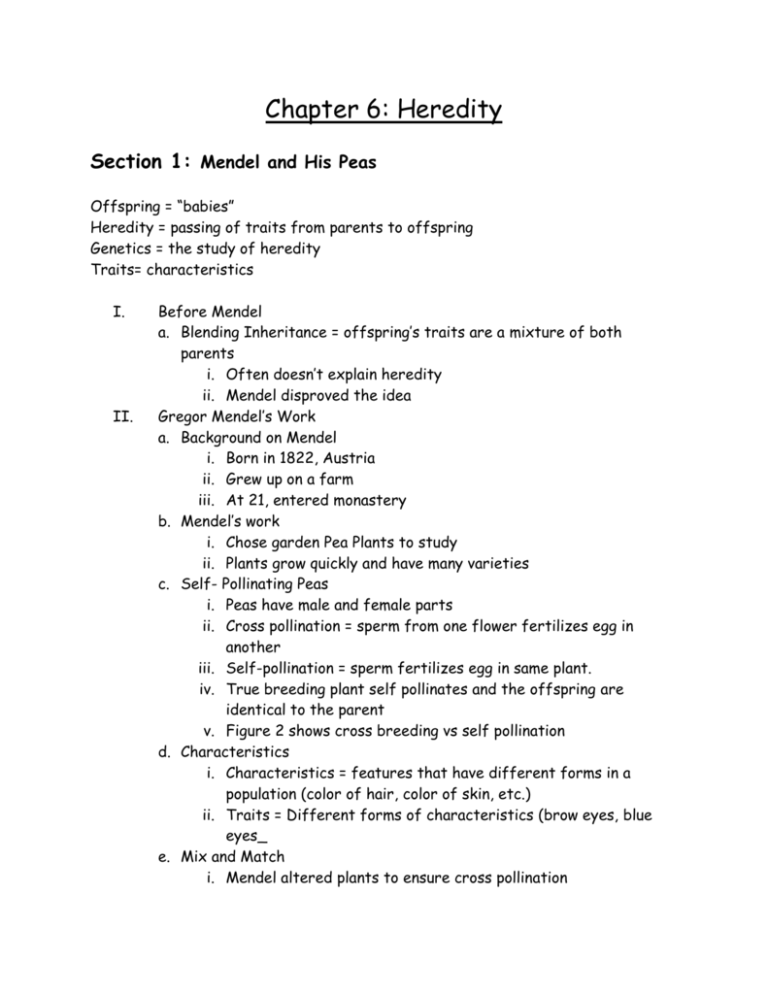
Chapter 6: Heredity Section 1: Mendel and His Peas Offspring = “babies” Heredity = passing of traits from parents to offspring Genetics = the study of heredity Traits= characteristics I. II. Before Mendel a. Blending Inheritance = offspring’s traits are a mixture of both parents i. Often doesn’t explain heredity ii. Mendel disproved the idea Gregor Mendel’s Work a. Background on Mendel i. Born in 1822, Austria ii. Grew up on a farm iii. At 21, entered monastery b. Mendel’s work i. Chose garden Pea Plants to study ii. Plants grow quickly and have many varieties c. Self- Pollinating Peas i. Peas have male and female parts ii. Cross pollination = sperm from one flower fertilizes egg in another iii. Self-pollination = sperm fertilizes egg in same plant. iv. True breeding plant self pollinates and the offspring are identical to the parent v. Figure 2 shows cross breeding vs self pollination d. Characteristics i. Characteristics = features that have different forms in a population (color of hair, color of skin, etc.) ii. Traits = Different forms of characteristics (brow eyes, blue eyes_ e. Mix and Match i. Mendel altered plants to ensure cross pollination III. IV. ii. Figure 3 shows how he altered the plants Mendel’s First Experiments a. Used true breeder for different traits b. Offspring were called 1st generation i. Ex. Purple crossed with White.. All Purple offspring c. Dominant trait = trait that appeared in 1st generation d. Recessive trait = trait that disappeared Mendel’s 2nd Experiments a. 1st generation self pollinated and recessive trait reappeared. i. Fig. 4 has a great example b. Ratios in Mendel’s Experiments i. Ratio = relationship between 2 numbers ii. 3:1 ratio, dominant to recessive, in generation 2 c. Gregor Mendel- Gone but Not Forgotten i. He realized each plant must have 2 sets of instructions for each characteristic ii. Each parent must give ONE set of instructions iii. Mendel shared his wok but it was not understood for almost 30 years Section 2: Traits and Inheritance I. A Great Idea a. Genes = the set of instructions on traits passed from parent to offspring i. Each parent gives one set ii. Offspring has 2 forms/ versions of the same gene for each characteristic (1 from mom, 1 from dad) iii. Different versions = alleles 1. Dominant alleles = CAPITOL LETTERS 2. Recessive alleles = lowercase letters a. In order to show a recessive trait, an organism must have 2 copies of the recessive trait b. DOMINANT + DOMINANT = DOMINANT c. DOMINANT + recessive = DOMINANT d. recessive + recessive = recessive II. III. IV. b. Phenotype i. Phenotype = organism’s appearance (example curly hair, straight hair) c. Genotype i. Genotype = both alleles the organism has for a trait 1. Homozygous = 2 of the same alleles (2 DOM or 2 rec) 2. Heterozygous = 2 different alleles (1 DOM and 1 rec) d. Punnett Squares i. Tool used to predict possible genotypes of offspring ii. Example e. More Evidence for Inheritance i. Mendel had 1st generation self pollinate ii. Punnett Square What are the Chances a. Parents have 2 alleles for a trait, so there is a 50/50 chance of passing each one to offspring b. Probability i. Probability = mathematical chance something will happen More About Traits a. One Gene, Many Traits i. Sometimes 1 gene influences many traits. Example- white fur in tigers also influences blue eye color ii. Genetic Disorders: result from error on one or more alleles 1. Ex: sickle cell b. Many genes, 1 trait i. Several genes responsible for 1 trait 1. Ex: skin, hair, eye color c. Importance of Environment i. Traits also determined by environment 1. Ex: height influence by nutrition Genetic Variation a. Genetic variation = differences in the sets of alleles between individuals in a population b. Genes affect traits inside a body too i. Some genes direct cell activities ii. Some genes direct production of enzymes, hormones, etc. Section 3: Meiosis Meiosis is the process where parents decrease their genetic material by half so their offspring doesn’t get double I. II. III. IV. Chromosome Numbers a. Every species has a specific number of chromosomes b. Usually every chromosome hangs out in the cell in long strands, but they shrink up into short, thick sticks right before the cell divides c. Homologous chromosomes i. 1 homologous chromosomes= chromosomes that carry the same set of genes (they may have different forms/alleles) Chromosomes in Reproduction a. Diploid = cells with homologous chromosomes (body cells) b. Haploid = cells with 1 chromosome (sex cells, sperm and egg) c. Sperm (haploid) + egg (haploid) = zygote (diploid)..mitosis..mitosis.. becomes a baby Meiosis a. Meiosis = copying process that makes sex cells with half the usual chromosomes i. Ex: mama has 46 + daddy has 46 = baby with 46 (egg has 23) (sperm has 23) b. Steps of Meiosis i. Chromosomes copied (1 cell) ii. Nuclear membrane disappears and chromosomes line up iii. Chromosomes separate from similar partners iv. Nuclear forms and cell divides (2 cells) v. Nucleus disappears again, chromosomes line up vi. Chromatids pull apart vii. Nucleus re-forms, cells divide (4 cells) Meiosis and Mendel a. Meiosis explains Mendel’s results b. Meiosis and Inheritance i. Half genes come from mom and half from dad

